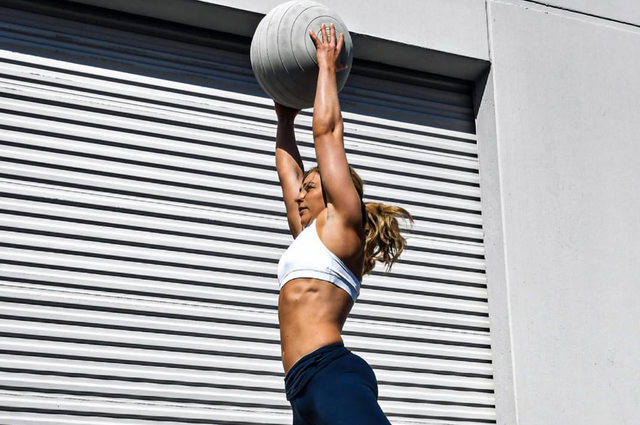If you want stronger, more defined shoulders, better posture, and greater upper body power, you need to be doing the military press. Also known as the overhead press, this classic barbell movement builds serious strength in your deltoids, triceps, traps, and core, while improving overhead mobility and total-body stability.
In this article, you’ll learn, what the military press is and how to do it properly, key benefits for strength, muscle growth, and posture, the muscles worked during the press, a full workout routine featuring the military press, and how to program it effectively, plus supplement and coaching recommendations.
What Is the Military Press?
The military press is a strict overhead barbell press performed while standing. Unlike push presses or jerks, the movement eliminates leg drive and emphasizes pressing strength from the shoulders and upper chest using core and spinal stability for support.
It’s one of the most effective vertical pressing movements for building functional upper-body strength, increasing shoulder hypertrophy, and improving athletic performance.
“The standing military press produces significant activation of the deltoids, triceps, and trapezius while requiring spinal and pelvic stabilization from the core musculature.” — Saeterbakken et al., Journal of Strength and Conditioning Research
Benefits of the Military Press
Shoulder Strength and Size
The military press targets all three heads of the deltoids—particularly the anterior delts—resulting in thicker, stronger shoulders.
Core and Spine Stability
Pressing heavy weight overhead while standing engages the transverse abdominis, spinal erectors, and obliques, improving postural control and total-body balance.
Improved Overhead Mobility
The strict pressing pattern encourages healthy shoulder joint mechanics and mobility through the thoracic spine and scapulae.
Functional Carryover
From Olympic lifts to everyday movement, strong overhead pressing translates to pushing strength, overhead performance, and injury resilience.
“Standing overhead lifts demand significant neuromuscular coordination and contribute to trunk and postural stability.” — Behm & Anderson, European Journal of Applied Physiology
Muscles Worked in the Military Press
| Muscle Group | Role in Movement |
|---|---|
| Deltoids (front, side) | Primary movers in pressing |
| Triceps Brachii | Extends elbows to push weight |
| Upper Chest (clavicular) | Assists shoulder flexion |
| Trapezius (upper/mid) | Stabilizes scapula during press |
| Core (abs, obliques) | Stabilizes trunk and spine |
| Spinal Erectors | Supports upright posture |
How to Perform the Military Press
Step-by-Step Guide
-
Set-Up: Stand with your feet hip-width apart. The barbell should rest across the front of your shoulders, with your hands just outside shoulder-width.
-
Brace Core: Tighten your abs and glutes, keeping a neutral spine. Avoid leaning back.
-
Press: Drive the bar overhead in a straight path, pushing your head slightly forward once the bar clears your forehead.
-
Lockout: Fully extend your arms overhead, with biceps close to your ears. Pause briefly.
-
Return: Lower the bar under control back to shoulder level, keeping elbows slightly in front of the bar.
Pro Tips
-
Keep wrists stacked and elbows slightly in front of the bar (not flared out).
-
Avoid overarching the lower back—tighten your glutes and brace your core.
-
Use a hook grip or standard overhand grip, depending on preference.
-
Use fractional plates for progressive overload.
Sample Military Press Strength Workout
Here’s a structured upper body pressing session featuring the military press:
| Exercise | Sets | Reps | Notes |
|---|---|---|---|
| Barbell Military Press | 5 | 5 | Strength-focused, 90 sec rest |
| Dumbbell Arnold Press | 3 | 8–10 | Shoulder hypertrophy |
| Pull-Ups or Lat Pulldown | 3 | 8–12 | Antagonist muscle pairing |
| Dumbbell Lateral Raises | 3 | 12–15 | Isolation + hypertrophy |
| Seated Overhead Triceps Extension | 3 | 10–12 | Triceps finisher |
Optional Finisher:
Barbell Complex: 3 rounds (Military Press → Push Press → Front Squat → Deadlift) x 5 reps each
Programming Tips for the Military Press
-
Frequency: 1–2x/week for strength or hypertrophy
-
Reps: 4–6 for strength, 8–12 for size
-
Tempo: Controlled descent (eccentric), explosive press
-
Progression: Add 2.5–5 lb per week or cycle volume/intensity every 4–6 weeks
-
Mobility: Warm up with banded shoulder openers or thoracic extensions
Supplement and Coaching Recommendations
Performance Supplements for Overhead Strength
-
Creatine Monohydrate – Supports ATP production and heavy lifts
→ Swolverine Creatine Monohydrate -
Beta-Alanine – Helps buffer muscle fatigue in higher-rep sets
→ Swolverine Beta-Alanine -
Citrulline Malate – Boosts nitric oxide for increased blood flow
→ Swolverine PRE
Personalized Strength Coaching
Want to build your overhead press and upper body strength with a targeted training plan and dialed-in nutrition?
→ Start Coaching at The Swole Kitchen
Final Thoughts: Why the Military Press Should Be in Your Program
The military press is one of the most effective and time-tested exercises for building upper body strength, shoulder size, and total-body control. Whether you're chasing a stronger barbell overhead or just want to improve posture and shoulder health, this foundational lift belongs in every serious strength program.
Push hard. Press clean. And own the overhead position.







